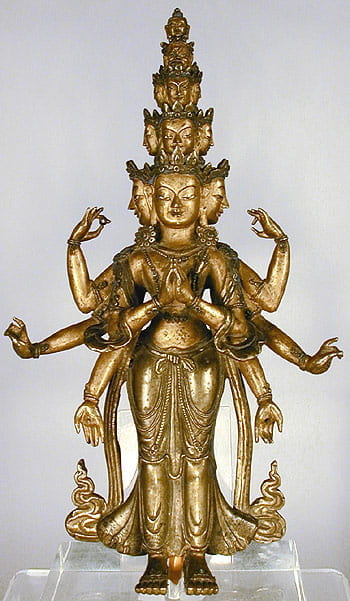Compassionate Beings
Suggested Grade Level: Upper elementary, middle school
Subject: Visual Art
Estimated Time: 2 class sessions

Avalokiteshvara with Eleven Heads and Eight Arms
Sino-Tibetan (Tibetan style, made in China), 18th-19th century
Gilded bronze
Pacific Asia Museum Collection
Gift of David Uyematsu, 1995.20.2
Introduction
Why does this sculpture have so many heads and arms? This sculpture shows a bodhisattva, who is a person who has almost attained the enlightenment that the Buddha achieved. Unlike the like the Buddha, a bodhisattva (it’s a fun word to say: BO-DEE-SAT-VA!) has put off his or her final enlightenment to help the rest of us humans. Because we need so much help, this bodhisattva has eleven heads and eight arms.
This bodhisattva is Avalokiteshvara (try saying it fast: AH-VAH-LOH-KEE-TESH-VARA) who is beloved by Buddhists everywhere. This bodhisattva is considered to be the most compassionate of them all. What is compassion? It is understanding others’ pain, hunger, and fear and the desiring to help others overcome their suffering. Compassion is a value that is important to Buddhists and indeed to most people.
Lesson Objectives
- Understand basic Buddhist concepts, including the practice of compassion and helping others who are suffering.
- Creating an artwork that shows virtues valued by the student.
Key Terms
Bodhisattva
Compassion
Enlightenment
Gesture
Mudra
Sculpture
Symbol
Value
Discussion
Ask students if they know why this sculpture has so many heads and arms? (Just how many does it have? Count them!) Why do they think this statue is golden? It’s golden because the artist who made it wanted to show how much he loved and respected this bodhisattva and wanted everyone who saw the statue to understand this and perhaps feel the same way.
If students look closely at an image of the statue, they’ll find that some of Avalokiteshvara’s hands form special gestures called mudras. Other hands hold objects. One hand is holding a lotus flower, which symbolizes purity. Explain that objects in many works of art from many countries stand for ideas, events, or people. For example, U.S. money has many symbols on it, which students can be asked to identify.
Activities
Avalokiteshvara is a compassionate bodhisattva, but others are wise, bring good health, or are fair. Have students brainstorm values that are important to them individually or in large or small groups. Is courage important to them? How about honesty? Have students brainstorm objects or animals that they associate with these values. For example, if bravery is a value they admire, they might say it is symbolized by a lion.
Point out that this artwork is a kind of work known as a sculpture. Some sculptures are carved from larger pieces, others are cast in molds, just as this work was. Today, students will either shape their work from a larger lump of modeling clay or add smaller pieces to form the figure they desire.
Instead of modeling a human figure holding a symbol, ask students to make a large version of the symbol itself to represent their values. Modeling clay to be shaped in the form of the object and decorated with recycled objects that can themselves be symbols. Display the figures in your class’s own museum of powerful beings!
Extension
Search the database of USC Pacific Asia Museum’s online collection. Can you find any other bodhisattvas? Any other artworks showing Avalokiteshvara? How are they different than this sculpture? How are they the same?
Standards
Visual Arts Standards: Discuss properties of works of art such as color, shapes, forms, textures; identify and describe symbols and icons; understand historical and cultural context of an artwork.